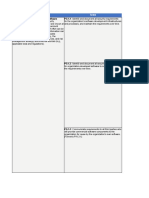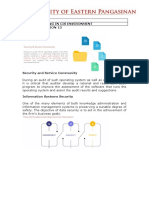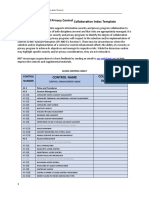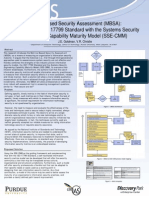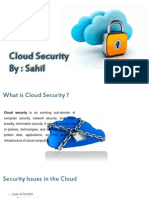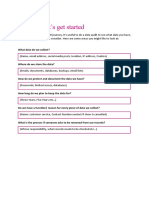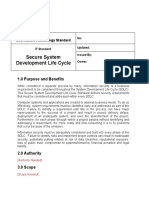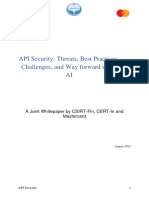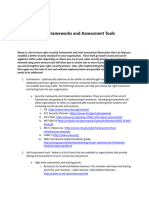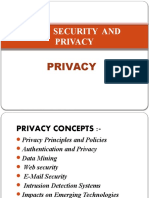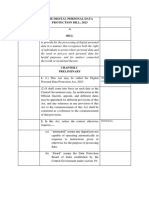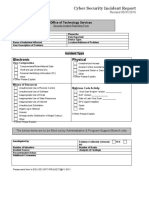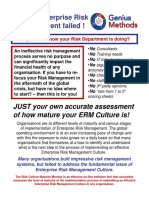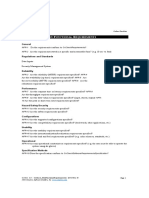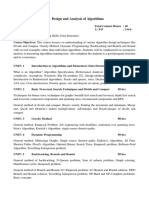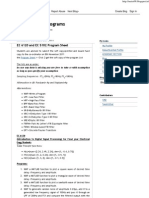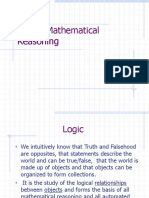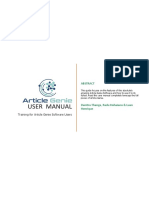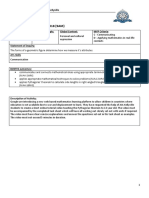Secure Coding Practices
Uploaded by
Amr M. AminSecure Coding Practices
Uploaded by
Amr M. AminSecure Coding Practices
Input Validation
Conduct all data validation on a trusted system (example: The server)
Identify all data sources and classify them into trusted and untrusted. Validate all data
from untrusted sources (e.g. file streams, web service calls etc.)
It is recommended to have centralised input validation routine for the application.
Specify proper character sets, such as UTF-8, for all sources of input
Encode data to a common character set before validating (Canonicalize); this is to
reduce various encodings and representations of data to a single simple form
All validation failures should result in input rejection
Determine if the system supports UTF-8 extended character sets and if so, validate after
UTF-8 decoding is completed
Validate all client provided data before processing, including all parameters, URLs and
HTTP header content (example: Cookie names and values). Be sure to include
automated post backs from JavaScript, Flash or other embedded code.
Verify that header values in both requests and responses contain only ASCII characters
Validate data from redirects (An attacker may submit malicious content directly to the
target of the redirect, thus circumventing application logic and any validation performed
before the redirect)
Validate for expected data types, data range and data length
Validate all input against “White List” Or “Black List”, whichever is appropriate. However
White list approach is recommended for input validation
If any potentially hazardous characters must be allowed as input, be sure that you
implement additional controls like output encoding, secure task specific APIs and
accounting for the utilization of that data throughout the application . Examples of
common hazardous characters include: < > " ' % ( ) & + \ \' \" (refer Security Invalid
Characters).
Discrete checks should be implemented for following inputs, if standard validation
routine cannot address;
Check for null bytes (%00)
Check for new line characters (%0d, %0a, \r, \n)
Check for “dot-dot-slash” (../ Or ..\) path alteration characters. In cases where UTF-8 extended
character set encoding is supported, address alternate representation like; %c0%ae%c0%ae/
(Utilize canonicalization to address double encoding or other forms of obfuscation attacks)
Output Encoding
Conduct all encoding on a trusted system (e.g., The server)
Utilize a standard, tested routine for each type of outbound encoding
Contextually output encode all data returned to the client that originated outside the
application's trust boundary. HTML entity encoding is one example, but does not work
in all cases
Encode all characters unless they are known to be safe for the intended interpreter
Contextually sanitize all output of un-trusted data to queries for SQL, XML, and LDAP
Sanitize all output of un-trusted data to operating system commands
Authentication and Password Management
Authentication
Use a centralized implementation for all authentication controls, including libraries that
call external authentication services
Segregate authentication logic from the resource being requested and use redirection to
and from the centralized authentication control
If application manages a credential store, it should ensure that only cryptographically
strong one-way salted hashes of passwords are stored and that the table/file that stores
the passwords and keys is write-able only by the application. (Do not use the MD5
algorithm if it can be avoided)
Password hashing must be implemented on a trusted system (e.g., The server)
Validate the authentication data only on completion of all data input, especially for
sequential authentication implementations
Authentication failure responses should not indicate which part of the authentication
data was incorrect. For example, instead of "Invalid username" or "Invalid password",
just use "Invalid username and/or password" for both. Error responses must be truly
identical in both display and source code
Utilize authentication for connections to external systems that involve sensitive
information or functions
Authentication credentials for accessing services external to the application should be
encrypted and stored in a protected location on a trusted system (e.g., The server). The
source code is NOT a secure location
Use only HTTP POST requests to transmit authentication credentials
Re-authenticate users prior to performing critical operations, session
verification/refresh authentication
Use multi-factor authentication for highly sensitive or high value transactional accounts.
Require authentication for all pages and resources, except those specifically intended to
be public
All authentication controls must be enforced on a trusted system (e.g., The server)
Establish and utilize standard, tested, authentication services whenever possible
All authentication controls should fail securely
All administrative and account management functions must be at least as secure as the
primary authentication mechanism
If using third party code for authentication, inspect the code carefully to ensure it is not
affected by any malicious code
Password Management
Only send non-temporary passwords over an encrypted connection or as encrypted
data, such as in an encrypted email. Temporary passwords associated with email resets
may be an exception
Temporary passwords and links should have a short expiration time and Enforce the
changing of temporary passwords on the next use
Enforce password complexity requirements established by policy or regulation.
Authentication credentials should be sufficient to withstand attacks that are typical of
the threats in the deployed environment. (e.g., requiring the use of alphabetic as well as
numeric and/or special characters)
Enforce password length requirements established by policy or regulation. Eight
characters is commonly used, but 16 is better or consider the use of multi-word pass
phrases
Password entry should be obscured on the user's screen. (e.g., on web forms use the
input type "password")
Enforce account disabling after an established number of invalid login attempts (e.g.,
five attempts is common). The account must be disabled for a period of time sufficient
to discourage brute force guessing of credentials, but not so long as to allow for a
denial-of-service attack to be performed
Password reset and changing operations require the same level of controls as account
creation and authentication.
Password reset questions should support sufficiently random answers. (e.g., "favorite
book" is a bad question because “The Bible” is a very common answer)
If using email based resets, only send email to a pre-registered address with a
temporary link/password
Notify users when a password reset occurs
Prevent password re-use
Passwords should be at least one day old before they can be changed, to prevent
attacks on password re-use
Enforce password changes based on requirements established in policy or regulation.
Critical systems may require more frequent changes. The time between resets must be
administratively controlled
Disable "remember me" functionality for password fields
The last use (successful or unsuccessful) of a user account should be reported to the
user at their next successful login
Implement monitoring to identify attacks against multiple user accounts, utilizing the
same password. This attack pattern is used to bypass standard lockouts, when user IDs
can be harvested or guessed
Change all vendor-supplied default passwords and user IDs or disable the associated
accounts
Only send non-temporary passwords over an encrypted connection or as encrypted
data, such as in an encrypted email. Temporary passwords associated with email resets
may be an exception
Temporary passwords and links should have a short expiration time and Enforce the
changing of temporary passwords on the next use by redirecting to the required change
password page or relevant error pages
Enforce password complexity requirements established by policy or regulation. When
the requirements change, ensure that existing passwords meet the requirements.
Authentication credentials should be sufficient to withstand attacks that are typical of
the threats in the deployed environment. (e.g., requiring the use of alphabetic as well as
numeric and/or special characters)
Enforce password length requirements established by policy or regulation. Eight
characters is commonly used, but 16 is better or consider the use of multi-word pass
phrases
Password entry should be obscured on the user's screen. (e.g., on web forms use the
input type "password")
Enforce account disabling after an established number of invalid login attempts (e.g.,
five attempts is common). The account must be disabled for a period of time sufficient
to discourage brute force guessing of credentials, but not so long as to allow for a
denial-of-service attack to be performed
Password reset and changing operations require the same level of controls as account
creation and authentication.
Password reset questions should support sufficiently random answers. (e.g., "favorite
book" is a bad question because “The Bible” is a very common answer)
If using email based resets, only send email to a pre-registered address with a
temporary link/password
Notify users when a password reset occurs
Prevent password re-use
Passwords should be at least one day old before they can be changed, to prevent
attacks on password re-use
Enforce password changes based on requirements established in policy or regulation.
The requirements could define the miminum number of uppercase or lowercase
alphabets, numbers, allow certain special characters and deny other characters. Critical
systems may require more frequent changes. The time between resets must be
administratively controlled
Disable "remember me" functionality for password fields
The last use (successful or unsuccessful) of a user account should be reported to the
user at their next successful login
Implement monitoring to identify attacks against multiple user accounts, utilizing the
same password. This attack pattern is used to bypass standard lockouts, when user IDs
can be harvested or guessed
Change all vendor-supplied default passwords and user IDs or disable the associated
accounts
Session Management
Use the server or framework’s session management controls. The application should
only recognize these session identifiers as valid
Session identifier creation must always be done on a trusted system (e.g., The server)
Session management controls should use well vetted algorithms that ensure sufficiently
random session identifiers
Set the domain and path for cookies containing authenticated session identifiers to an
appropriately restricted value for the site
Logout functionality should fully terminate the associated session or connection
Logout functionality should be available from all pages protected by authorization
Establish a session inactivity timeout that is as short as possible, based on balancing risk
and business functional requirements. In most cases it should be no more than several
hours
Disallow persistent logins and enforce periodic session terminations, even when the
session is active. Especially for applications supporting rich network connections or
connecting to critical systems. Termination times should support business requirements
and the user should receive sufficient notification to mitigate negative impacts
If a session was established before login, close that session and establish a new session
after a successful login
Generate a new session identifier on any re-authentication
Do not allow concurrent logins with the same user ID
Do not expose session identifiers in URLs, error messages or logs. Session identifiers
should only be located in the HTTP cookie header. For example, do not pass session
identifiers as GET parameters
Protect server side session data from unauthorized access, by other users of the server,
by implementing appropriate access controls on the server
Generate a new session identifier and deactivate the old one periodically. (This can
mitigate certain session hijacking scenarios where the original identifier was
compromised)
Generate a new session identifier if the connection security changes from HTTP to
HTTPS, as can occur during authentication. Within an application, it is recommended to
consistently utilize HTTPS rather than switching between HTTP to HTTPS.
Supplement standard session management for sensitive server-side operations, like
account management, by utilizing per-session strong random tokens or parameters. This
method can be used to prevent Cross Site Request Forgery attacks
Supplement standard session management for highly sensitive or critical operations by
utilizing per-request, as opposed to per-session, strong random tokens or parameters
Set the "secure" attribute for cookies transmitted over an TLS connection
Set cookies with the HttpOnly attribute, unless you specifically require client-side scripts
within your application to read or set a cookie's value
Access Control
Use only trusted system objects, e.g. server side session objects, for making access
authorization decisions
Use a single site-wide component to check access authorization. This includes libraries
that call external authorization services
Access controls should fail securely
Deny all access if the application cannot access its security configuration information
Enforce authorization controls on every request, including those made by server side
scripts, "includes" and requests from rich client-side technologies like AJAX and Flash
Segregate privileged logic from other application code
Restrict access to files or other resources, including those outside the application's
direct control, to only authorized users
Restrict access to protected URLs to only authorized users
Restrict access to protected functions to only authorized users
Restrict direct object references to only authorized users
Restrict access to services to only authorized users
Restrict access to application data to only authorized users
Restrict access to user and data attributes and policy information used by access
controls
Restrict access security-relevant configuration information to only authorized users
Server side implementation and presentation layer representations of access control
rules must match
If state data must be stored on the client, use encryption and integrity checking on the
server side to catch state tampering.
Enforce application logic flows to comply with business rules
Limit the number of transactions a single user or device can perform in a given period of
time. The transactions/time should be above the actual business requirement, but low
enough to deter automated attacks
Use the "referer" header as a supplemental check only, it should never be the sole
authorization check, as it is can be spoofed
If long authenticated sessions are allowed, periodically re-validate a user’s authorization
to ensure that their privileges have not changed and if they have, log the user out and
force them to re-authenticate
Implement account auditing and enforce the disabling of unused accounts (e.g., After no
more than 30 days from the expiration of an account’s password.)
The application must support disabling of accounts and terminating sessions when
authorization ceases (example: Changes to role, employment status, business process,
etc.)
Service accounts or accounts supporting connections to or from external systems should
have the least privilege possible
Create an Access Control Policy to document an application's business rules, data types
and access authorization criteria and/or processes so that access can be properly
provisioned and controlled. This includes identifying access requirements for both the
data and system resources
Cryptographic Practices
All cryptographic functions used to protect secrets from the application user must be
implemented on a trusted system (example: The server)
Protect master secrets from unauthorized access
Cryptographic modules should fail securely
All random numbers, random file names, random GUIDs, and random strings should be
generated using the cryptographic module’s approved random number generator when
these random values are intended to be un-guessable
Cryptographic modules used by the application should be compliant to FIPS 140-2 or an
equivalent standard. (See http://csrc.nist.gov/groups/STM/cmvp/validation.html)
Establish and utilize a policy and process for how cryptographic keys will be managed
Error Handling and Logging
Do not disclose sensitive information in error responses, including system details,
session identifiers or account information
Use error handlers that do not display debugging or stack trace information
Implement generic error messages and use custom error pages
The application should handle application errors and not rely on the server
configuration
Properly free allocated memory when error conditions occur
Error handling logic associated with security controls should deny access by default
All logging controls should be implemented on a trusted system (example: The server)
Logging controls should support both success and failure of specified security events
Ensure logs contain important log event data
Ensure log entries that include un-trusted data will not execute as code in the intended
log viewing interface or software
Restrict access to logs to only authorized individuals
Utilize a master routine for all logging operations
Do not store sensitive information in logs, including unnecessary system details, session
identifiers or passwords
Ensure that a mechanism exists to conduct log analysis
Log all input validation failures
Log all authentication attempts, especially failures
Log all access control failures
Log all apparent tampering events, including unexpected changes to state data
Log attempts to connect with invalid or expired session tokens
Log all system exceptions
Log all administrative functions, including changes to the security configuration settings
Log all backend TLS connection failures
Log Cryptographic module failures
Use a cryptographic hash function to validate log entry integrity
Data Protection
Implement least privilege, restrict users to only the functionality, data and system
information that is required to perform their tasks
Protect all cached or temporary copies of sensitive data stored on the server from
unauthorized access and purge those temporary working files a soon as they are no
longer required.
Encrypt highly sensitive stored information, like authentication verification data, even
on the server side. Always use well vetted algorithms, see "Cryptographic Practices" for
additional guidance
Protect server-side source-code from being downloaded by a user
Do not store passwords, connection strings or other sensitive information in clear text
or in any non-cryptographically secure manner on the client side. This includes
embedding in insecure formats like: MS viewstate, Adobe flash or compiled code
Remove comments in user accessible production code that may reveal back-end system
or other sensitive information
Remove unnecessary application and system documentation as this can reveal useful
information to attackers
Do not include sensitive information in HTTP GET request parameters
Disable auto complete features on forms expected to contain sensitive information,
including authentication
Disable client side caching on pages containing sensitive information. Cache-Control: no-
store, may be used in conjunction with the HTTP header control "Pragma: no-cache",
which is less effective, but is HTTP/1.0 backward compatible
The application should support the removal of sensitive data when that data is no longer
required. (example: personal information or certain financial data)
Implement appropriate access controls for sensitive data stored on the server. This
includes cached data, temporary files and data that should be accessible only by specific
system users
Communication Security
Implement encryption for the transmission of all sensitive information. This should
include TLS for protecting the connection and may be supplemented by discrete
encryption of sensitive files or non-HTTP based connections
TLS certificates should be valid and have the correct domain name, not be expired, and
be installed with intermediate certificates when required
Failed TLS connections should not fall back to an insecure connection
Utilize TLS connections for all content requiring authenticated access and for all other
sensitive information
Utilize TLS for connections to external systems that involve sensitive information or
functions
Utilize a single standard TLS implementation that is configured appropriately
Specify character encodings for all connections
Filter parameters containing sensitive information from the HTTP referer, when linking
to external sites
System Configuration
Ensure servers, frameworks and system components are running the latest approved
version
Ensure servers, frameworks and system components have all patches issued for the
version in use
Turn off directory listings
Restrict the web server, process and service accounts to the least privileges possible
When exceptions occur, fail securely
Remove all unnecessary functionality and files
Remove test code or any functionality not intended for production, prior to deployment
Prevent disclosure of your directory structure in the robots.txt file by placing directories
not intended for public indexing into an isolated parent directory. Then "Disallow" that
entire parent directory in the robots.txt file rather than Disallowing each individual
directory
Define which HTTP methods, Get or Post, the application will support and whether it will
be handled differently in different pages in the application
Disable unnecessary HTTP methods, such as WebDAV extensions. If an extended HTTP
method that supports file handling is required, utilize a well-vetted authentication
mechanism
If the web server handles both HTTP 1.0 and 1.1, ensure that both are configured in a
similar manor or insure that you understand any difference that may exist (e.g. handling
of extended HTTP methods)
Remove unnecessary information from HTTP response headers related to the OS, web-
server version and application frameworks
The security configuration store for the application should be able to be output in
human readable form to support auditing
Implement an asset management system and register system components and software
in it
Isolate development environments from the production network and provide access
only to authorized development and test groups. Development environments are often
configured less securely than production environments and attackers may use this
difference to discover shared weaknesses or as an avenue for exploitation
Implement a software change control system to manage and record changes to the code
both in development and production
Database Security
•Use strongly typed parameterized queries
•Utilize input validation and output encoding and be sure to address meta characters. If these
fail, do not run the database command
•Ensure that variables are strongly typed
•The application should use the lowest possible level of privilege when accessing the database
•Use secure credentials for database access
•Connection strings should not be hard coded within the application. Connection strings should
be stored in a separate configuration file on a trusted system and they should be encrypted.
•Use stored procedures to abstract data access and allow for the removal of permissions to the
base tables in the database
•Close the connection as soon as possible
•Remove or change all default database administrative passwords. Utilize strong
passwords/phrases or implement multi-factor authentication
•Turn off all unnecessary database functionality (e.g., unnecessary stored procedures or
services, utility packages, install only the minimum set of features and options required (surface
area reduction))
•Remove unnecessary default vendor content (e.g., sample schemas)
•Disable any default accounts that are not required to support business requirements
•The application should connect to the database with different credentials for every trust
distinction (e.g., user, read-only user, guest, administrators)
File Management
•Do not pass user supplied data directly to any dynamic include function
•Require authentication before allowing a file to be uploaded
•Limit the type of files that can be uploaded to only those types that are needed for business
purposes
•Validate uploaded files are the expected type by checking file headers. Checking for file type
by extension alone is not sufficient
•Do not save files in the same web context as the application. Files should either go to the
content server or in the database.
•Prevent or restrict the uploading of any file that may be interpreted by the web server.
•Turn off execution privileges on file upload directories
•Implement safe uploading in UNIX by mounting the targeted file directory as a logical drive
using the associated path or the chrooted environment
•When referencing existing files, use a white list of allowed file names and types. Validate the
value of the parameter being passed and if it does not match one of the expected values, either
reject it or use a hard coded default file value for the content instead
•Do not pass user supplied data into a dynamic redirect. If this must be allowed, then the
redirect should accept only validated, relative path URLs
•Do not pass directory or file paths, use index values mapped to pre-defined list of paths
•Never send the absolute file path to the client
•Ensure application files and resources are read-only
•Scan user uploaded files for viruses and malware
Memory Management
•Utilize input and output control for un-trusted data
•Double check that the buffer is as large as specified
•When using functions that accept a number of bytes to copy, such as strncpy(), be aware that
if the destination buffer size is equal to the source buffer size, it may not NULL-terminate the
string
•Check buffer boundaries if calling the function in a loop and make sure there is no danger of
writing past the allocated space
•Truncate all input strings to a reasonable length before passing them to the copy and
concatenation functions
•Specifically close resources, don’t rely on garbage collection. (e.g., connection objects, file
handles, etc.)
•Use non-executable stacks when available
•Avoid the use of known vulnerable functions (e.g., printf, strcat, strcpy etc.)
•Properly free allocated memory upon the completion of functions and at all exit points
General Coding Practices
•Use tested and approved managed code rather than creating new unmanaged code for
common tasks
•Utilize task specific built-in APIs to conduct operating system tasks. Do not allow the
application to issue commands directly to the Operating System, especially through the use of
application initiated command shells
•Use checksums or hashes to verify the integrity of interpreted code, libraries, executables, and
configuration files
•Utilize locking to prevent multiple simultaneous requests or use a synchronization mechanism
to prevent race conditions
•Protect shared variables and resources from inappropriate concurrent access
•Explicitly initialize all your variables and other data stores, either during declaration or just
before the first usage
•In cases where the application must run with elevated privileges, raise privileges as late as
possible, and drop them as soon as possible
•Avoid calculation errors by understanding your programming language's underlying
representation and how it interacts with numeric calculation. Pay close attention to byte size
discrepancies, precision, signed/unsigned distinctions, truncation, conversion and casting
between types, "not-a-number" calculations, and how your language handles numbers that are
too large or too small for its underlying representation
•Do not pass user supplied data to any dynamic execution function
•Restrict users from generating new code or altering existing code
•Review all secondary applications, third party code and libraries to determine business
necessity and validate safe functionality, as these can introduce new vulnerabilities
•Implement safe updating. If the application will utilize automatic updates, then use
cryptographic signatures for your code and ensure your download clients verify those
signatures. Use encrypted channels to transfer the code from the host server
Security Invalid Characters
Invalid form field Input characters
Regular Expression Character Description
\"[\s]*\)[\s]*\; ");
\'[\s]*\)[\s]*\; '); Or ' ) ;
\/\* /*
\*\/ */
\'[\s]*\+ '+ Single quote followed by + sign
\'[\s]*\= '= Single quote followed by = sign
\"[\s]*\= "= Double quote followed by = sign
\.\.\/ ../ DOT-DOT-SLASH
\.\.\\ ..\ DOT-DOT-SLASH
<script <script
scr[\W] scr( Or scr= scr followed by any non alpha character
META META
img img
div div
form form
object object
applet applet
embed embed
frameset frameset
iframe iframe
a> a>
javascript\: javascript:
document\.write document.write
document\.cookie document.cookie
href followed by = (with or without spaces
href[\s]*= href= Or href =
in between)
String\.fromCharCode String.fromCharCode
expression[\s]* expression this is a method in javascript
eval\([\W] eval( Or eval= Or eval" Or eval' eval followed by any non alpha character
onAbort followed by any non alpha
onAbort[\W] onAbort( Or onAbort=
character
onActivate( Or onActivate= Or onActivate followed by any non alpha
onActivate[\W]
onActivate" character
onAfter followed by any non alpha
onAfter[\W] onAfter( Or onAfter= Or onAfter"
character
onBefore[\W] onBefore followed by any non alpha
character
onBlur followed by any non alpha
onBlur[\W]
character
onBounce followed by any non alpha
onBounce[\W]
character
onBegin followed by any non alpha
onBegin[\W]
character
onCellChange followed by any non alpha
onCellChange[\W]
character
onChange followed by any non alpha
onChange[\W]
character
onClick followed by any non alpha
onClick[\W]
character
onContextMenu followed by any non alpha
onContextMenu[\W]
character
onControlSelect followed by any non alpha
onControlSelect[\W]
character
onCopy followed by any non alpha
onCopy[\W]
character
onCut[\W] onCut followed by any non alpha character
onDataAvailable followed by any non alpha
onDataAvailable[\W]
character
onDatasetChange followed by any non
onDatasetChange[\W]
alpha character
onDatasetComplete followed by any non
onDatasetComplete[\W]
alpha character
onDblClick followed by any non alpha
onDblClick[\W]
character
onDeactivate followed by any non alpha
onDeactivate[\W]
character
onDrag followed by any non alpha
onDrag[\W]
character
onDrop followed by any non alpha
onDrop[\W]
character
onError followed by any non alpha
onError[\W]
character
onFilterChange followed by any non alpha
onFilterChange[\W]
character
onFinish followed by any non alpha
onFinish[\W]
character
onFocus followed by any non alpha
onFocus[\W]
character
onHelp followed by any non alpha
onHelp[\W]
character
onKey followed by = (with or without
onKey[\s]*= onKey= Or onKey =
spaces in between)
onLayoutComplete followed by any non
onLayoutComplete[\W]
alpha character
onLoad followed by any non alpha
onLoad[\W]
character
onLoseCapture followed by any non alpha
onLoseCapture[\W]
character
onMouseDown followed by any non alpha
onMouseDown[\W]
character
onMouseEnter followed by any non alpha
onMouseEnter[\W]
character
onMouseLeave followed by any non alpha
onMouseLeave[\W]
character
onMouseMove followed by any non alpha
onMouseMove[\W]
character
onMouseOut followed by any non alpha
onMouseOut[\W]
character
onMouseOver followed by any non alpha
onMouseOver[\W]
character
onMouseUp followed by any non alpha
onMouseUp[\W]
character
onMouseWheel followed by any non alpha
onMouseWheel[\W]
character
onMove followed by any non alpha
onMove[\W]
character
onPaste followed by any non alpha
onPaste[\W]
character
onPropertyChange followed by any non
onPropertyChange[\W]
alpha character
onReadyStateChange followed by any non
onReadyStateChange[\W]
alpha character
onReset followed by any non alpha
onReset[\W]
character
onResize followed by any non alpha
onResize[\W]
character
onRowEnter followed by any non alpha
onRowEnter[\W]
character
onRowExit followed by any non alpha
onRowExit[\W]
character
onRowsDelete followed by any non alpha
onRowsDelete[\W]
character
onRowsInserted followed by any non alpha
onRowsInserted[\W]
character
onScroll followed by any non alpha
onScroll[\W]
character
onSelect followed by any non alpha
onSelect[\W]
character
onSelectionChange followed by any non
onSelectionChange[\W]
alpha character
onSelectStart followed by any non alpha
onSelectStart[\W]
character
onStart followed by any non alpha
onStart[\W]
character
onSubmit followed by any non alpha
onSubmit[\W]
character
onTimeError followed by any non alpha
onTimeError[\W]
character
onUnload followed by any non alpha
onUnload[\W]
character
onMessage followed by any non alpha
onMessage[\W]
character
Appendix B: Glossary
Abuse Case: Describes the intentional and unintentional misuses of the software. Abuse cases
should challenge the assumptions of the system design.
Access Control: A set of controls that grant or deny a user, or other entity, access to a system
resource. This is usually based on hierarchical roles and individual privileges within a role, but
also includes system to system interactions.
Authentication: A set of controls that are used to verify the identity of a user, or other entity,
interacting with the software.
Availability: A measure of a system’s accessibility and usability.
Canonicalize: to reduce various encodings and representations of data to a single simple form.
Communication Security: A set of controls that help ensure the software handles the sending
and receiving of information in a secure manner.
Confidentiality: To ensure that information is disclosed only to authorized parties
Contextual Output Encoding: Encoding output data based on how it will be utilized by the
application. The specific methods vary depending on the way the output data is used. If the
data is to be included in the response to the client, account for inclusion scenarios like: the
body of an HTML document, an HTML attribute, within JavaScript, within a CSS or in a URL. You
must also account for other use cases like SQL queries, XML and LDAP.
Cross Site Request Forgery: An external website or application forces a client to make an
unintended request to another application that the client has an active session with.
Applications are vulnerable when they use known, or predictable, URLs and parameters; and
when the browser automatically transmits all required session information with each request to
the vulnerable application. (This is one of the only attacks specifically discussed in this
document and is only included because the associated vulnerability is very common and poorly
understood.)
Cryptographic Practices: A set of controls that ensure cryptographic operations within the
application are handled securely.
Data Protection: A set of controls that help ensure the software handles the storing of
information in a secure manner.
Database Security: A set of controls that ensure that software interacts with a database in a
secure manner and that the database is configured securely.
Error Handling and Logging: A set of practices that ensure the application handles errors safely
and conducts proper event logging.
Exploit: To take advantage of a vulnerability. Typically this is an intentional action designed to
compromise the software's security controls by leveraging a vulnerability.
File Management: A set of controls that cover the interaction between the code and other
system files.
General Coding Practices: A set of controls that cover coding practices that do not fit easily into
other categories.
Hazardous Character: Any character or encoded representation of a character that can affect
the intended operation of the application or associated system by being interpreted to have a
special meaning, outside the intended use of the character. These characters may be used to:
Altering the structure of existing code or statements
Inserting new unintended code
Altering paths
Causing unexpected outcomes from program functions or routines
Causing error conditions
Having any of the above effects on downstream applications or systems
HTML Entity Encode: The process of replacing certain ASCII characters with their HTML entity
equivalents. For example, encoding would replace the less than character "<" with the HTML
equivalent "<". HTML entities are 'inert' in most interpreters, especially browsers, which can
mitigate certain client side attacks.
Impact: A measure of the negative effect to the business that results from the occurrence of an
undesired event; what would be the result of a vulnerability being exploited.
Input Validation: A set of controls that verify the properties of all input data matches what is
expected by the application including types, lengths, ranges, acceptable character sets and does
not include known hazardous characters.
Integrity: The assurance that information is accurate, complete and valid, and has not been
altered by an unauthorized action.
Log Event Data: This should include the following:
Time stamp from a trusted system component
Severity rating for each event
Tagging of security relevant events, if they are mixed with other log entries
Identity of the account/user that caused the event
Source IP address associated with the request
Event outcome (success or failure)
Description of the event
Memory Management: A set of controls that address memory and buffer usage.
Mitigate: Steps taken to reduce the severity of a vulnerability. These can include removing a
vulnerability, making a vulnerability more difficult to exploit, or reducing the negative impact of
a successful exploitation.
Multi-Factor Authentication: An authentication process that requires the user to produce
multiple distinct types of credentials. Typically this is based on something they have (example:
smartcard), something they know (example: a pin), or something they are (e.g., data from a
biometric reader).
Output Encoding: A set of controls addressing the use of encoding to ensure data output by the
application is safe.
Parameterized Queries (prepared statements): Keeps the query and data separate through the
use of placeholders. The query structure is defined with place holders, the SQL statement is
sent to the database and prepared, and then the prepared statement is combined with the
parameter values. This prevents the query from being altered, because the parameter values
are combined with the compiled statement, not a SQL string.
Sanitize Data: The process of making potentially harmful data safe through the use of data
removal, replacement, encoding or escaping of the characters.
Security Controls: An action that mitigates a potential vulnerability and helps ensure that the
software behaves only in the expected manner.
Security Requirements: A set of design and functional requirements that help ensure the
software is built and deployed in a secure manner.
Sequential Authentication: When authentication data is requested on successive pages rather
than being requested all at once on a single page.
Session Management: A set of controls that help ensure web applications handle HTTP sessions
in a secure manner.
State Data: When data or parameters are used, by the application or server, to emulate a
persistent connection or track a client's status across a multi-request process or transaction.
System: A generic term covering the operating systems, web server, application frameworks
and related infrastructure.
System Configuration: A set of controls that help ensure the infrastructure components
supporting the software are deployed securely.
Threat Agent: Any entity which may have a negative impact on the system. This may be a
malicious user who wants to compromise the system's security controls; however, it could also
be an accidental misuse of the system or a more physical threat like fire or flood.
Trust Boundaries: Typically a trust boundary constitutes the components of the system under
your direct control. All connections and data from systems outside of your direct control,
including all clients and systems managed by other parties, should be consider untrusted and
be validated at the boundary, before allowing further system interaction.
Vulnerability: A weakness that makes the system susceptible to attack or damage.
External References:
Cited Reference
Sans and TippingPoint "The Top Cyber Security Risks"
http://www.sans.org/top-cyber-security-risks/
Web Application Security Consortium
http://www.webappsec.org/
Common Weakness Enumeration (CWE)
http://cwe.mitre.org/
Department of Homeland Security
Build Security In Portal
https://buildsecurityin.us-cert.gov/daisy/bsi/home.html
CERT Secure Coding
http://www.cert.org/secure-coding/
MSDN Security Developer Center
http://msdn.microsoft.com/en-us/security/default.aspx
SQL Injection Cheat Sheet
http://ferruh.mavituna.com/sql-injection-cheatsheet-oku/
Cross Site Scripting (XSS) Cheat Sheet
http://ha.ckers.org/xss.html
Security Advisory Sites:
Useful resources to check for known vulnerabilities against supporting infrastructure and
frameworks
Secunia Citrix Vulnerability List:
http://secunia.com/advisories/search/?search=citrix
Security Focus Vulnerability Search:
http://www.securityfocus.com/vulnerabilities
Open Source Vulnerability Database (OSVDB):
http://osvdb.org/search/web_vuln_search
Common Vulnerability Enumeration:
http://www.cve.mitre.org/
You might also like
- PCI DSS Compliance Planning Guide - Windows SecurityNo ratings yetPCI DSS Compliance Planning Guide - Windows Security47 pages
- ISO27k Model Policy On Security Awareness and Training100% (1)ISO27k Model Policy On Security Awareness and Training4 pages
- 1 Information Security Audit and Analysis Introduction 02-08-2021 (02 Aug 2021) Material - I - 02 Aug 2021 - 01 - Introduction100% (1)1 Information Security Audit and Analysis Introduction 02-08-2021 (02 Aug 2021) Material - I - 02 Aug 2021 - 01 - Introduction37 pages
- Auditing in CIS Environment DISCUSSION 13No ratings yetAuditing in CIS Environment DISCUSSION 137 pages
- Isc2 Cissp 1 13 1 Threat Modeling Concepts and MethodologiesNo ratings yetIsc2 Cissp 1 13 1 Threat Modeling Concepts and Methodologies2 pages
- Security and Privacy Control Collaboration Index TemplateNo ratings yetSecurity and Privacy Control Collaboration Index Template36 pages
- MIS802 Business Continuity Information SecurityNo ratings yetMIS802 Business Continuity Information Security111 pages
- Passing Unix Linux Audit With Power Broker100% (2)Passing Unix Linux Audit With Power Broker11 pages
- GDPR Compliance Checklist ProjectManager FD CMNo ratings yetGDPR Compliance Checklist ProjectManager FD CM12 pages
- Information Security Management System ManualNo ratings yetInformation Security Management System Manual17 pages
- IBA Karachi - VAPT - Revalidation ReportNo ratings yetIBA Karachi - VAPT - Revalidation Report32 pages
- (Win2k16) Certificate Autoenrollment in Windows Server 2016No ratings yet(Win2k16) Certificate Autoenrollment in Windows Server 201645 pages
- 2018.1 Example CSOP WISP NIST CSF MappingNo ratings yet2018.1 Example CSOP WISP NIST CSF Mapping12 pages
- Application Security & Code Review GuideNo ratings yetApplication Security & Code Review Guide7 pages
- An Evaluation Framework For Cybersecurity Maturity Aligned With The NIST CSFNo ratings yetAn Evaluation Framework For Cybersecurity Maturity Aligned With The NIST CSF20 pages
- Mastering A Zero Trust Security StrategyNo ratings yetMastering A Zero Trust Security Strategy1 page
- ISO 27001 Documents Required For CertificationNo ratings yetISO 27001 Documents Required For Certification4 pages
- Aligning PCI DSS With ISO 27001 - ISMS - OnlineNo ratings yetAligning PCI DSS With ISO 27001 - ISMS - Online14 pages
- Cyber Security Incident Report: Electronic PhysicalNo ratings yetCyber Security Incident Report: Electronic Physical1 page
- Dale Carnegie How To Win Friends and Influence People0% (1)Dale Carnegie How To Win Friends and Influence People11 pages
- ISA IEC 62443 Cybersecurity Certification - A Guide75% (4)ISA IEC 62443 Cybersecurity Certification - A Guide19 pages
- 14 Algorithms Every Programmer Needs To KnowNo ratings yet14 Algorithms Every Programmer Needs To Know16 pages
- Non-Functional Requirements SpecificationsNo ratings yetNon-Functional Requirements Specifications7 pages
- Argusoft Program Analyst 100 Questions With Answers FULL100% (1)Argusoft Program Analyst 100 Questions With Answers FULL10 pages
- Understanding Arrays: Types, Operations, and ExamplesNo ratings yetUnderstanding Arrays: Types, Operations, and Examples12 pages
- Grow Taller After Puberty PDF Grow Taller After Puberty PDFNo ratings yetGrow Taller After Puberty PDF Grow Taller After Puberty PDF2 pages
- 6.006 Introduction To Algorithms: Mit OpencoursewareNo ratings yet6.006 Introduction To Algorithms: Mit Opencourseware6 pages
- Iso 13485 & 21 CFR 820 Template Documentation Operational Procedure Qop 42 01 Control of Documents100% (1)Iso 13485 & 21 CFR 820 Template Documentation Operational Procedure Qop 42 01 Control of Documents9 pages
- User Manual: Training For Article Genie Software UsersNo ratings yetUser Manual: Training For Article Genie Software Users25 pages
- Term 3 Assessment Task Mathematics - Pythagoras TheoremNo ratings yetTerm 3 Assessment Task Mathematics - Pythagoras Theorem8 pages
- Data Mining Term Project Machine Learning With WEKA: Weka Explorer Tutorial For Version 3.4.3No ratings yetData Mining Term Project Machine Learning With WEKA: Weka Explorer Tutorial For Version 3.4.342 pages
- Variable Selection in SAS Enterprise Guide and SAS Enterprise Miner - Ask The Expert - May 11 2017No ratings yetVariable Selection in SAS Enterprise Guide and SAS Enterprise Miner - Ask The Expert - May 11 201766 pages
- CRD - 12-Application For Opening Account and Credit Facilities FormNo ratings yetCRD - 12-Application For Opening Account and Credit Facilities Form3 pages









